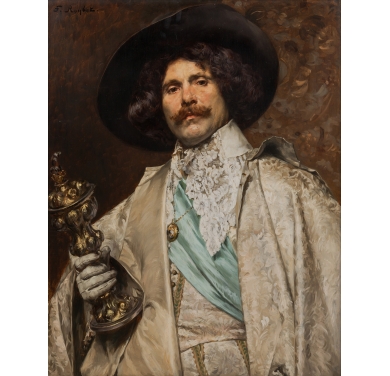Ferdinand Roybet (1840-1920) - Gentleman holding a hanap in his hand
Oil on mahogany panel, signed upper left
Dimensions : H. 82 x W. 66 cm (with frame: H. 108 x W. 91 cm)
Ferdinand Roybet was one of the leading figures in portraiture and interior scenes at the end of the 19th century. He studied drawing and engraving at the Lyon School of Fine Arts. His talent was quickly noticed and he left for Paris to continue his training. When he was just 24, his painting "Un fou sous Henri III" (A madman under Henry III) was exhibited at the official Salon in Paris: the painting was acquired by Princess Mathilde, who was the fiancée of Emperor Napoleon III. Roybet's reputation was now established, and his painting style would remain unchanged.
In 1871, Roybet discovered the paintings of Franz Hals and Rembrandt during a stay in Holland. From Franz Hals, Roybet retained the power of form, and from Rembrandt the fervor and quest for the soul. The artist painted these figures, dressed in 17th-century fashion, with quick, precise strokes. Roybet quickly won numerous medals at the Universal Exhibitions in Antwerp (1894), Berlin and Vienna.
Ferdinand Roybet's success during his lifetime gave him the financial means to produce his finest works on large solid mahogany panels, which were unaffordable at the end of the 19th century. These panels enabled his great portraits to reach us in often perfect condition.
In 1927, the Roybet Fould Museum opened its doors in Courbevoie, just outside Paris. Created by Consuelo Fould, a painter and granddaughter of Napoleon III's finance minister, the museum houses a collection of Roybet paintings bequeathed by the founder.
Our painting is a magnificent portrait of Roybet. It is a large, highly accomplished work, with rare attention to detail. The man's posture has been skilfully studied, plunging us immediately into the 17th century with a powerful, wealthy and intelligent figure. The man is proud, his head slightly bowed. In his gloved hand, he holds a gilt hanap, and the richness of his clothes bears witness to his rank.
The colours in this painting follow a subtle harmony: the icy brown background, the hat and the dark brown hair are of the same tone; the beige colours of the clothes pick up this same tone with infinite gradations down to the white of the teeth. The face itself is part of this chromatic balance. Only the celadon-green scarf establishes a diagonal on which the composition rests.
In this portrait, Roybet shows his incredible talent for sketching details with a quick, light touch. His painting is like a link between the past that he enjoyed depicting and the artistic modernity of the late 19th century. This portrait is painted on a superb beveled solid mahogany panel, and is in absolutely perfect condition.
Museums:
Avignon, Bordeaux, Musée d'Orsay, Mulhouse, New York, Courbevoie Musée Roybet Fould, etc…






